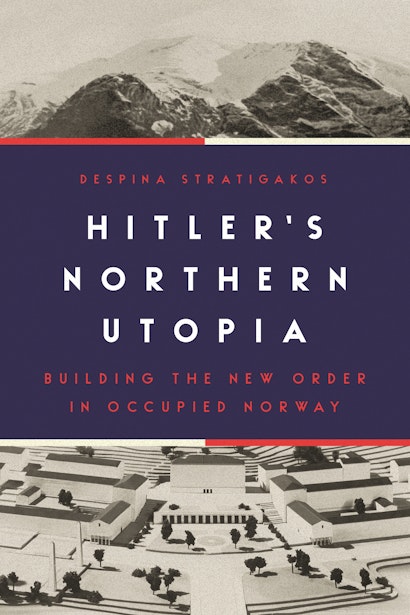Between 1940 and 1945, German occupiers transformed Norway into a vast construction zone. This remarkable building campaign, largely unknown today, was designed to extend the Greater German Reich beyond the Arctic Circle and turn the Scandinavian country into a racial utopia. From ideal new cities to a scenic superhighway stretching from Berlin to northern Norway, plans to remake the country into a model “Aryan” society fired the imaginations of Hitler, his architect Albert Speer, and other Nazi leaders. In Hitler’s Northern Utopia, Despina Stratigakos provides the first major history of Nazi efforts to build a Nordic empire—one that they believed would improve their genetic stock and confirm their destiny as a new order of Vikings.
What led you to write this book?
DS: It started with a chance encounter in the German Federal Archives in Berlin. While researching another subject, I came across a file about Hitler’s secret plans to build a city in occupied Norway. I knew nothing about the Nazis’ building projects in this northern country and so I went to the library. Coming home with a book on the history of Norwegian architecture, I was disappointed to see that the chapters skipped from 1940 to 1945. I didn’t believe those years were blank, and that unwritten chapter turned into the book.
That void is surprising, given that your book documents a massive building campaign in occupied Norway. How do you account for that missing history?
DS: A perfect storm of circumstances obstructed our vision. It took a very long time—almost 70 years—for the National Archives of Norway in Oslo to process the mountain of documents left behind by Hitler’s engineering divisions in Norway, which were responsible for much of the work. Our preconceptions of what a National Socialist-built landscape looks like also got in the way—by the time the Germans arrived in Norway, Nazi ideas on architecture and power were shifting and focusing more on everyday spaces. The occupiers’ infrastructural projects also played a big role in Norway, and those tend to be less conspicuous as physical relics of the past. Fortunately, many of the Nazis’ construction schemes were never completed, sparing Norway’s landscapes more extensive damage, although there are far more surviving remnants than you would expect. Finally, this is an uncomfortable history for many Norwegians, touching on collaborations with the occupiers that are now being more widely exposed by a younger generation of Norwegian historians and journalists, who paint a murkier picture of the occupation than previous accounts.
What is an example of the everyday spaces that interested the Nazis in Norway?
DS: An important example is the attention given to the reconstruction of Norwegian towns—everything from the size of roads and public squares to the height of buildings and even the angle of rooftops. Many Norwegian towns suffered extensive damage in the 1940 invasion. Albert Speer oversaw the Norwegian architects entrusted with the reconstruction. He viewed the destruction as an opportunity to align these towns with National Socialist-urban planning ideals intended to create model “Aryan” communities. In November 1940, he organized a study tour of German and Austrian towns for Norwegian architects, who were wined and dined and given tours of Nazi buildings and urban settlements by leading Third Reich architects. Speer expected the visitors to take these lessons back to Norway, where they would forge suitable urban settings for a new society. He and his staff oversaw the subsequent plans created by the Norwegian architects, who continued to be pressured to conform to Nazi ideals.
Why wine and dine the Norwegian architects? Why didn’t Speer just order them to build what he wanted?
DS: It might be hard for us to imagine, but even after he invaded their country, Hitler thought he could befriend the Norwegians. Unlike their views of Eastern Europe’s Jewish and Slavic peoples, Nazi leaders believed that Norwegians were racially superior to Germans and invaluable to their mission to purify Germany’s so-called Aryan population through selective breeding. The Nazis’ vast construction schemes in Norway were intended to literally and symbolically build bridges to the local inhabitants, bringing them into the Nordic brotherhood of the Greater German Reich.
How does Hitler’s desire to build a new city in Norway factor into this vision?
DS: It actually points to an immense contradiction. Despite Nazi propaganda in German and Norwegian newspapers—proclaiming Hitler’s intentions to treat Norwegians as equals in the Greater German Reich—the plans for the new city expose an altogether different reality. Albert Speer designed the city, to be located south of Trondheim, as a place restricted to German residents and as a German cultural beacon in the north, with institutions focused solely on German culture. Hitler’s plans, which included the construction of a vast naval base near the city, were kept secret from Norwegians for fear they would inflame the resistance. As I explored the Nazis’ building schemes, it became clear that although they valued the Norwegians’ genes, they did not actually want to mingle too closely with the people. The Nazis were drawn to the North but suspicious of its “untamed” nature. In the book I explore other instances of the German occupiers building spatial and cultural bubbles in Norway to protect themselves from supposed dangerous influences.
Ultimately, are Hitler’s engineers and architects in Norway building for Germans or Norwegians or both?
DS: Above all, the German occupiers were building an empire; many of the projects were intended for the postwar period, when the Nazis expected to reign supreme. When we look to Norway, we see what Hitler and his architects were planning for the world under the swastika, which they had already begun to build in Norway. We also see how the Nazis imagined themselves in relation to the North, a place both physical and mystical to them. The Nazis never planned to leave Norway, despite public pronouncements to the contrary. Instead, they saw the invasion of Norway as a homecoming. The Nazis believed that Germans had originated in the North and were finally returning, making the land their own again. Building was central to their strategy of re-appropriation—after all, Hitler had dreamed of becoming an architect as a young man, and that desire later influenced his methods of empire building. For all these reasons, the occupying Nazis invested enormous resources in the effort to remake Norway. Ultimately, that transformation was in the service of their imagined Aryan empire and their role as its masters.
Despina Stratigakos is a vice provost and professor of architecture at the University at Buffalo, State University of New York. She is the author of Hitler at Home and Where Are the Women Architects? (Princeton), and has written on Nazi Germany for Architect Magazine, BBC History Magazine, and the Atlantic. She lives in Buffalo, New York.

